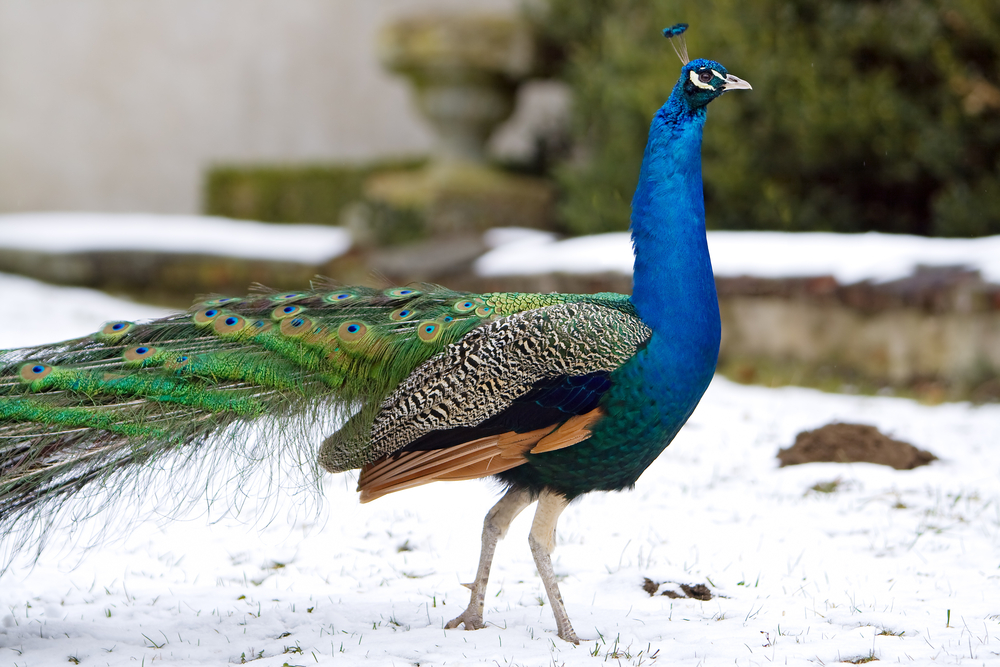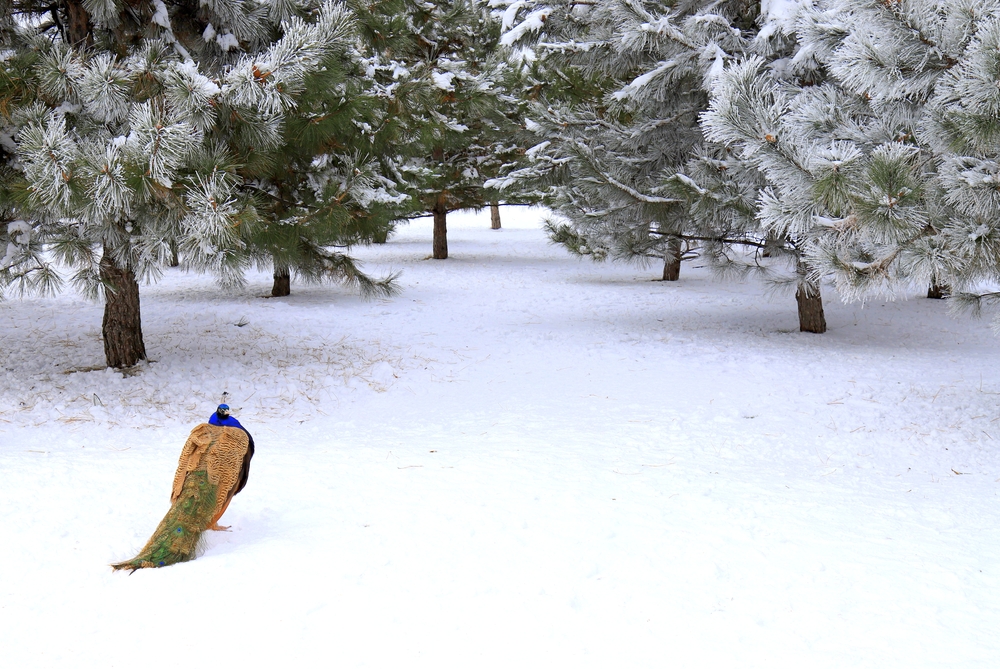When you are taking care of peacocks in the winter, they need to be housed in a setting where they can be kept warm.
Peacocks have a natural internal system that allows them to stay warm, but in extreme cold, it is not enough.
A structure such as a barn or other facility that shelters them from the cold can help, and it may help them to have additional features in places such as lighting or heat lamps to keep them warm.
Peacocks have a natural internal system that helps them stay warm in the winter, but still need shelter and warmth during extreme temperatures.
A coop or cage can help peacocks stay warm, but it is often not enough. A barn or other facility with lighting and heat lamps can help peacocks stay warm and lively all winter long.
Table of Contents
Can peacocks handle winter climates?

Yes, peacocks can survive and handle the winter and extreme temperatures when they are well taken care of.
Peacocks are tropical birds, and so they do not have as many built-in internal mechanisms to stay warm during the winter as some other birds.
These birds come from Africa, India, and Sri Lanka, where extreme cold is not a factor in their daily survival.
Still, they can survive extreme cold when they have the proper structure and care to help them do so.
Like many animals, peacocks can adapt to their surroundings, and they will during the winter months.
While most birds have the natural ability to adapt to their surrounding in order to survive the conditions, but these adaptations will be limited.
Exposure to winter climates could be extremely dangerous to peacocks. If you want to maintain their health and ensure they have the appropriate lifespan, you will need to take the steps necessary to help them survive and adapt to winter climates.
Even in the best of climates, domesticating a peacock can be difficult, so there will be additional challenges faced during the winter months.

Can peacocks survive the winter in a cage?
During the warmest seasons, it is difficult to cage this beautiful flying bird. Peacocks typically do not like to be caged as this makes flying impossible.
The beautiful, long fan of feathers that makes up most of their body length is an important consideration when you are building a cage or coop for your peacock.
If you are building one that is meant for the winter months, you should make those considerations prior to construction.
You can add adaptations to the cage or coop before winter that will winterize the cage when the time comes.
This will make it easier for you to care for the peacock in the cold months and also make it easier for the peacock to adjust.
With winterized adaptations to a cage or coop, the transition from warmer to cooler temperatures in a seasonal climate will be easier for the peacock.
A cage or a coop can work for a peacock, but it will need to be large enough for them to spread their beautiful wings and tails.

Ensure that the cage or coop that you provide for them has ample space for them to walk around and feel free despite the fact that they are not.
Is it dangerous to keep a peacock outside during winter?
It is dangerous to keep a peacock outside during the winter, particularly if the winter season is lengthy in your area.
Peacocks can stay warm on their own but will need some additional help. When winter arrives, a winterized cage or coop that is well maintained can help them stay warm in extreme temperatures.
However, bringing them inside a larger building such as a barn, shed, or garage may help them to stay warm.
Indoor shelter is always best for peacocks that live in extreme climates.
Peacocks do have an internal system that can help them to stay warm in the winter, but everything you can do to provide warmth for them will help.
The dangers of not providing shelter for peacocks during the winter include frostbite and freezing to death.

They may survive but could lose some of their extremities which will negatively impact their quality of life.
The more you can do to help a peacock stay warm during the winter, the happier the bird will be.
How do peacocks stay warm naturally?
Peacocks have a natural inclination to stay warm and have a routine with preening and working their feathers to maximize their internal warmth.
Because of this, peacocks can survive a little bit of cooler temperatures. In most cases, they do not have a problem staying warm at night when the temperatures dip a little bit.
That is because the peacock has a way of exchanging heat within their own internal systems to regulate their blood flow and internal body temperature.
When these systems are healthy, peacocks have a warm blood flow to their extremities that helps them to warm up their whole body.
The feet are the most at risk at first when a peacock is exposed to cold temperatures.
When the peacock has normal blood flow, like humans and any other animal, the legs and the feet are warm enough to keep the entire body warm.

In addition to proper blood flow, peacocks also have scales on the outside of their feet, and this helps to winterize them from cold and extreme precipitation.
Peacocks also have oil that lines their skin and their feathers and serves as an additional layer of insulation in cool or extreme climates.
What is the best way to keep peacocks warm during winter?
The best way to keep peacocks warm during the winter is to provide the right cage or shelter that will help them to stay warm.
You may also want to allow them to have enough room to move around and use their own body to stay warm.
Peacocks have a natural fat layer that helps to insulate them, and this gives them energy for warmth and also helps them to generate the heat they need when they are feeling cold.
They will also fluff their feathers to provide air pockets that help them to stay warm. If you see your peacock doing a lot of fluffing of the feathers, they may be telling you they need more warmth.

A cage or even a perch near warmth will help them tremendously.
An Interior shelter with straw and nesting material will likely always be the warmest place to keep your peacock.
You want to include nesting material on the floors of their shelters as well to help them to keep their feet warm.
Automatic lighting on their coops or shelter can help them to feel warm, and timed heating lamps will help as well.
Will diet help to keep peacocks warm?
It is natural to wonder if a diet will fatten up your peacock so that it can stay warm. The answer to this is yes, a good diet will help.
Ensuring that your peacock has a full and healthy diet is an excellent way to help your peacock stay warm during the winter, but it doesn’t necessarily need to be fattier foods.
On their own in the wild, peacocks survive on bugs and other protein-providing snacks. You can provide protein for them in the way of cat or dog food, and they will also eat raisins, figs, and even dates.

If you can find earthworms, peacocks will enjoy eating those as well.

















